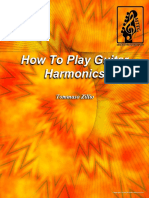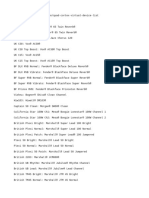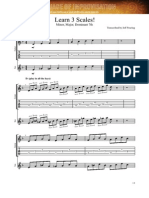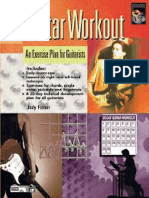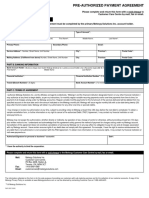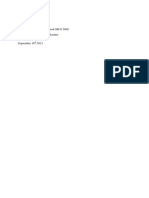0 ratings0% found this document useful (0 votes)
329 views12 pagesModes
Uploaded by
Amirhoosein MeshginiCopyright
© © All Rights Reserved
We take content rights seriously. If you suspect this is your content, claim it here.
Available Formats
Download as PDF or read online on Scribd
0 ratings0% found this document useful (0 votes)
329 views12 pagesModes
Uploaded by
Amirhoosein MeshginiCopyright
© © All Rights Reserved
We take content rights seriously. If you suspect this is your content, claim it here.
Available Formats
Download as PDF or read online on Scribd
You are on page 1/ 12
Major Scale Modes « Chap
Chapter 7
THE
MODES
OF
THE
MAJOR
SCALE
Three-Notes-per-String Scales
Modes
Tonal Colors
Pitch Axis System
Rock Gultar Secrets 60 {hist
Along with the more jaz-derived practice of dividing the fingerboard into five positions
(chapter 5, pg. 44), the usage of three-notes-per-string scales has become quite popular in
fecent years, especially in hard rock and metal.
This concept should already be somewhat familiar to you: in pattern 5 of the conventional
‘major scale patterns (see pg. 45) we've already dealt with this kind of fingering which we also
looked at in the previous chapter on alternate picking.
new division is advantageous not only because it makes the fingerboard easier to deal
with, especially when moving from the major scale to others, but because it also makes it easier
to apply techniques like alternate picking and legato all over the fingerboard.
THE SEVEN MODES OF THE MAJOR SCALE
Here are the seven new C major scale positions:
F- ly
B- locrian
— 6 Major Scale Modes « Chapter 7
C -ionian
SSS
E - phrygian
‘As you can see, I've added the name of the respective modes to the fingering positions.
Rock Guitar Secrets ee
62 =
‘The modal system works like this:
One can differentiate between scales either by comparing the intervallic combinations or the
sequence of whole and half steps within the scale.
For example, the major scale (or ionian mode) in C:
As you can see, the half steps occur between steps 3 and 4, and 7 and 8. This is true of all
major scales, regardless of what the tonic note is!
If we start the C major scale from D instead of C things look a bit different:
The positions of the half steps have changed (2/3 and 6/7) as well as the naming of the
intervals. This scale is the dorian scale.
If you start the C major scale from the remaining notes (E - F-G-A-B) the result will be the
five other modes: E phyrgian, F lydian, G mixolydian, A aeolian and 8 locrian.
Lach mode has a different structure.
PROJECT:
~ Write all the modes in the same manner and note how they‘re constructed.
a Major Scale Modes « Chapter 7
DRILL:
“In order to get the new scale positions down, here's a short scale drill:
let’s have a drill party, dude!
Play up and down In thirds
a) G-ydian d) F-ionian a) tb-ionian —_d) C-locrian
b) Bb-mixolydiane) B-aeolian b)Aphrygian —_e) G-dorian
©) Adorian f) Ab-locrian )Bb-Iydian £)C-mixolydian
In seconds In groups of four
a) B-aeolian d) A-mixolydian a) Gedorian d) G#-lydian
b) Bb-ionian e) G-phrygian b) Ephrygian —_e) F-locrian
©) Flydian 1) D-dorian ¢) D-mixolydianf) B-mixoh
PROJECT:
Guitarists like Steve Vai, Joe Satriani and Pat Metheny often play melody lines, licks
and sequences on a single string, that is they view the fingerboard horizontally,
lengthwise, instead of dividing it into scale positions (the vertical view). This keeps
you from getting stuck in a rut with scale positions. So try also playing the modes on
one string. As you practice, experiment with various phrasing devices like slides or
bending,
‘So what happens when all seven modes are built up from a single tonic note? The key changes!
Cionian Dee A ecco
Cdorian D & F G A Bb C=Bb-major
Cphrygian Db — F G Ab Bb C= Ab-major
Chdin =: DF FROG OA
Gmixoydian: D — F G A Bb
Caeolian =: Db F G Ab Bb C=Eb-major
Clocrian __: Db > _F _Gb_Ab_ Bb C= Bb-major
DRILL:
What are the names of the original major scales of the following modes?
a) Cdorian £) FHocrian
i b) Feionian 9) G-aeolian
©) Gelydian bh) B-mixolydian
d) E-phrygian i) 8b-dorian
) Armixolydian i) Clydian
Name the seven modes of these major scales.
a) G-major e) Femajor
b) Ab-major £) C-major
¢) E-major 9) Bb-major
d)_D-major h) FR-major
Answers on pg. 70!
Rock Guitar Secrets ea om
The main purpose of all this is to learn how to use the seven new patterns to play in one key all
over the fingerboard, or to be able to improvise in seven different keys in one fingerboard
position.
But that's just one side of the modal coin.
The other use to which you can put modes Is more of a compositional, or emotional nature.
At the beginning of the Baroque era (17th century) it was still common to compose in all the
modes. In order to counteract the strong similarity of the modes, it was decided at some point
to concentrate on the two most dissimilar sounding ones. The ionian became the major scale
and the aeolian became of course the minor. The difference between these two tone “colors”
can be recognized by practically anyone. Hardly used for several centuries, the modes and their
different tonal colorations are now finding use in rock, Jazz and pop music.
THE TONAL COLORS OF THE DIFFERENT MODES
Now we're going to get a handle on the different sounds that characterize each mode. In order
to do this, it’s important first to play and hear chord progressions for each one, so that later
you'll be able ta recognize the moods and colors of the different modes without having to
analyze them.
This probably sounds very difficult, if not downright impossible. But my personal experience
has been that music is often better learned ard assimilated intuitively than on an intellectual
level
MODAL CHORD PROGRESSIONS
Mode 1 - The lonian (Major) Mode
As you may already know, a major scale contains both "strong" and "weak" chords. The strong
chords are the ones based on the first, fourth and fifth steps of the scale:
In € major, therefore, C major, F major and G major are the strong chords. D minor, E minor,
A minor and B diminished are the weak ones.
To make a chord progression in the ionian mode, simply take the three strong chords and
arrange them in any order.
To make use of the convenient open A - string, the following examples are all in A.
:
D/A E/A
The chord symbols, by the way, are called slash chords. This means that the chord is played
‘over a non-chord-tone bass note. (Here an E major with an A in the bass).
In addition to these progressions you can, of course, simply play the ionian mode over the
diatonic chord built on the first note of the major scale.
ee Major Scale Modes + Chapter 7
Mode 2 - The Dorian Mode
‘A-dorian is the second mode of G major scale. The strong chords in G major are G major (1),
C major (4) and D major (5). Unfortunately, if you play these chords one after the other, they
sound like G major instead of A dorian. This is not the case if you play an A bass note under
these chords.
Jamtrack 1 1b
$A SS SE 7
This is yet another typical chord progression in A dorian, which is frequently heard in the
music of Santana, for example, who plays almost exclusively in the dorian mode.
& Am’ =D) |
In order to avoid having to memorize seven new finger positions for A dorian, | recommend
that you use the scale from which it’s derived - the G major scale ~ for improvising. This way
you only have to learn the seven fingering positions for the major scale once, and then shift
them around into whichever key you need.
Of course you can also use the dorian scale for jamming over the chord built on the second
step of the scale (II m 7th).
C/A:
Mode 3 - The Phrygian Mode
Using the same approach as with the first two modes we can construct a phrygian "vamp"
(chord progression):
A phrygian = 3rd mode of F major: 1 = F major, 4~ Bb major, 5 = C major.
jamtrack
—=C/A
F/A, BA. F/A
If you play this scale over its diatonic chord (m’), you'll immediately notice that although it’s
the same chord as in the dorian mode (m’), it has a totally different feeling.
Rock Gultar Secrets ee (5)
Mode 4 The Lydian Mode
A lydian = 4th mode of major: 1 = E major, 4= A major, 5 = B major.
Jamtrack 14
<—
:
—=B/A: = E/A: =p B/A.
The diatonic chord here is a major or a major 7th chord. Compared to the major scale, the
lydian mode sounds somewhat mysterious because of the presence of the #11 interval (in C
lydian the Fé as opposed to F in C major). This may be the reason why Steve Vai frequently
uses this mode,
Mode 5 The Mixolydian Mode
‘A mixo = Sth mode of D major:
[samerack 15 Eadie
a
In contrast to the major and minor chords, the dominant seventh chord built on the fifth
dagree of the tcale can (at this point anyway) only be assigned to one scale: the mivalydian
scale.
‘As most rock music is, due to its origins in the blues, built on dominant seventh chords, the
mixo scale is all but omnipresent.
= D major, 4= G major, 5 = A major
Here’s a tip! To bring out the blues flavor even more, an extra chromatic passing tone is often
used: the minor third. The resulting scale is the basis for a lot of Steve Morse’s solos.
PROJECT:
= Instead of the pentatonic (chapter 3, pg. 31, 32) play the respective mixolydian scales
over the blues form.
07 Major Scale Modes - Chapter 7
Mode 6 The Aeolian (natural minor) Mode
A aeolian = 6th mode of C major: 1 = C major, 4 = F major, 5 = G major
B/A. G/N: F/A
Beside the dorian and phrygian scales, the two “special” minor scales, there is of course the
"normal" minar scale with its sad, melancholic sound. It’s used primarily in heavy metal and in
ballads.
Mode 7 The Locrian Mode
A locrian = 7th mode of Bb major: 1 = Bb major, 4 = Eb major. 5 = F major
[tomtrack 17 Radikal
— I ———
This scale is perfect for the m’ chord, which is built on the seventh degree of the scale.
Otherwise, the locrian mode is not used for composiny in “Hurmal” ruck music, BUE then,
what's normal?
x BVA
So much for modal chord progressions.
Notice the tonal and emotional colors that you get when you play these progressions. Try also
to make connections between tonal colors and real colors or perhaps emotional or physical
reactions (joy, hate, sadness, thirst, lust), anyway it hits you ... let your imagination loose here.
What works with children and colors (green as grass, blue as the sky) also works with music.
Maybe it svunus a bit crazy, but we're here to have fun, aren’t we?
Rock Guitar Secrets 68
Here's a brief synopsis of the modes:
Once again, all examples in A:
lonian mode: AB CE DE FE GB, bright, cheerful sound chord:
A major, A maj?
Dorian mode: ABCD EFS, ballsy, funky sound chord:
Am’, most important note: major 6th (Fé)
Phyrgian mode: A Bb CD EF G, sounds a bit Spanish, the mysterious minor chord:
‘Am’, most important note: BD
tydian mode: AB CB D4 E F# GH, ethereal, mystical sound, the mysterious major chord:
A maj’, most important note: D4
Mixolydian mode A B C# D E Fé G, bluesy sound chord:
A’, most important notes G and C#
Aeolian mode: ABCDEFG, dark, sad sound, the sad minor chord:
Am’, most important note: F
Locrian mode: A Bb C_D Eb FG, very tense sound chord:
‘Ams
Here I'd like to mention my book "Masters of Rock Guitar", in which I've analyzed the musical
sources, playing techniques, sounds, etc. of twenty leading guitarists. Besides theoretical and
biographical information, the book contains over 250 licks in the styles of these pioneering rock
guitarists
THE PITCH AXIS SYSTEM
Another interesting application of the modal scales is the pitch axis concept which Joe Satriani
very frequently uses. This concept can easily be explained by means of the diagram below:
Satriani’s method is to choose a tonal center and then pick out chords from the different modal
areas, stringing them together into a unified sounding progression.
Iydian
Amaj’#; B/A; A’()’; maj’; Ama?
diatonic chords from E-major
aeolian t locrian
Csus*; Fmaj’/A -A— AS; BIA; BIA
diatonic chords from C-mayor fl diatonic chords fom B?-major, Ghar. minor
mixolydian
AT; asus!s; Asus
diatonic chords from D-major
Major Scale Modes - Chapter 7
69
Here is an example of a chord progression constructed with this system:
ash Ayousa pmei7ya ‘Atsass
(Adydian) J (A-mixolydian) | (A-aeolian) | (A-mixolydian)
This type of chord progression is ideal for practicing the modes, as all the scales deriving from a
particular tonal center vary by only a few notes.
Here’s another example which clearly illustrates the different ways of looking at a chord
progression.
| Jamtrack 18 zi
F/G: Ge ==En’: =D/E=
modal view: Gmixolydian x Edorian a
rom: Coane x rior Z
pitch-axis. ‘Gmixolydien x Giydian Lx
Here's another example:
Jamtrack 19 E23
es s 7B =
‘mado vow: Bb yeten
key centers Ferajor
Pitches Deaeolan
modal view Ederan lyin
eycanters:— Demajor anajor
pitches: Dionian Dionian
PROJECT:
= Apply the mega chops approach to all modal chord progressions.
70
Answers to page 63:
lydian mixolydian aeolian —locrian
dorian phrygian
ionian
PRG wach
wai doa
You might also like
- Module 5 - Modes and Other Scales Dan Amerson: I) Demystifying The ModesNo ratings yetModule 5 - Modes and Other Scales Dan Amerson: I) Demystifying The Modes26 pages
- Pentatonic Spice - Adding Modal Sounds To Your Boxes - Part 1 of 3No ratings yetPentatonic Spice - Adding Modal Sounds To Your Boxes - Part 1 of 35 pages
- Texas Blues Guitar - Robert Calva (Musicians Institute) Audios100% (1)Texas Blues Guitar - Robert Calva (Musicians Institute) Audios48 pages
- Guitar Scales Easy Music Lessons (PDFDrive)100% (1)Guitar Scales Easy Music Lessons (PDFDrive)19 pages
- Pentatonics and Blues Solo Mastery Module 2 Natural MinorNo ratings yetPentatonics and Blues Solo Mastery Module 2 Natural Minor6 pages
- Rodrigo Gouveia Neo Soul Fusion Master Class Vol.1 Study GuideNo ratings yetRodrigo Gouveia Neo Soul Fusion Master Class Vol.1 Study Guide76 pages
- Pentatonics and Blues Solo Mastery Module 4 Pentatonic and Blues Scales100% (1)Pentatonics and Blues Solo Mastery Module 4 Pentatonic and Blues Scales11 pages
- Advancing Guitarist Mick Goodrickpdf PDF FreeNo ratings yetAdvancing Guitarist Mick Goodrickpdf PDF Free109 pages
- (Ebook) Advanced Arpeggio Soloing For Guitar by Chris Brooks Digital Download67% (3)(Ebook) Advanced Arpeggio Soloing For Guitar by Chris Brooks Digital Download62 pages
- Fast - Rock - Guitar - Licks - James Shipway GuitarNo ratings yetFast - Rock - Guitar - Licks - James Shipway Guitar4 pages
- Scotthenderson Tribaltech Transcriptions Thebestof 140213070355 Phpapp01 PDF100% (1)Scotthenderson Tribaltech Transcriptions Thebestof 140213070355 Phpapp01 PDF141 pages
- Barre Chords (Or Bar Chords) Require One Finger To Fret Most or All of The Strings To Play TheNo ratings yetBarre Chords (Or Bar Chords) Require One Finger To Fret Most or All of The Strings To Play The4 pages
- 01.jazz Guitar Dominant Chord Substitutionsa100% (2)01.jazz Guitar Dominant Chord Substitutionsa101 pages
- Metal Guru - Rusty Cooley - Single-String Triads100% (2)Metal Guru - Rusty Cooley - Single-String Triads1 page
- Examining Rhythmic and Metric Practices in Led Zeppelin's Musical Style100% (1)Examining Rhythmic and Metric Practices in Led Zeppelin's Musical Style24 pages
- The Guitarists Guide To Set Up and MaintenanceNo ratings yetThe Guitarists Guide To Set Up and Maintenance56 pages
- Math Rock Guitar Techniques Practical Music Theory Ebook April 2023No ratings yetMath Rock Guitar Techniques Practical Music Theory Ebook April 202394 pages
- Gary Clark Jr - Guitar Tab Anthology - Hal LeonardNo ratings yetGary Clark Jr - Guitar Tab Anthology - Hal Leonard130 pages
- PDF 25 Classic Bebop Licks For Guitar Matt Warnock Amp Dirk Laukens - CompressNo ratings yetPDF 25 Classic Bebop Licks For Guitar Matt Warnock Amp Dirk Laukens - Compress15 pages
- Guitar Techniques - Pentatonic Scale Exercises PDF50% (2)Guitar Techniques - Pentatonic Scale Exercises PDF9 pages
- Guitar Modes & Scales - The Complete Beginner's Guide (+ Video - PDF)No ratings yetGuitar Modes & Scales - The Complete Beginner's Guide (+ Video - PDF)36 pages
- Please Complete and Return This Form With A Void Cheque To Customer Care Centre by Mail, Fax or EmailNo ratings yetPlease Complete and Return This Form With A Void Cheque To Customer Care Centre by Mail, Fax or Email1 page

























